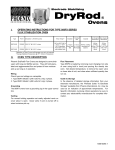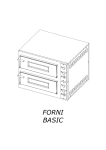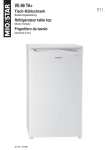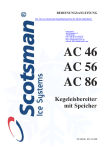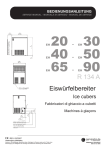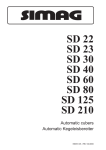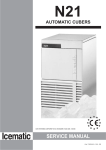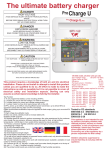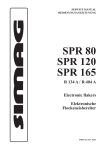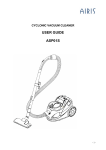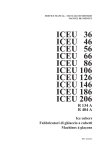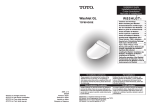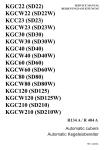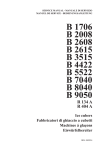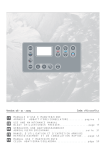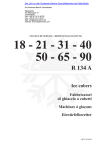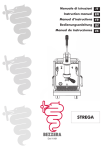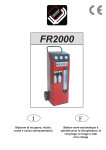Download SD 18 - 3/03
Transcript
SD 18 R 134a PRO VIS O IRE - SEU L EN ANG LAI S, IT ALI EN ET A LLE MA ND SERVICE MANUAL - MANUALE DI SERVIZIO MANUEL DE SERVICE - BEDIENUNGSANLEITUNG Ice cubers Fabbricatori di ghiaccio a cubetti Machines á glaçons Kegeleisbereiter REV. 03/2003 a) TABLE OF CONTENTS PAGE INDICE PAG TABLE DES MATIERES PAGE INHALT SEITE GENERAL INFORMATION AND INSTALLATION 1 INFORMAZIONI GENERALI ED INSTALLAZIONE 8 INFORMATIONS GENERALES ET INSTALLATION 15 ALLGEMEINES UND INSTALLATION Introduction Unpacking and inspection Location and levelling 1 1 1 Introduzione 8 Disimballaggio ed ispezione 8 Posizionamento e livellamento 10 Introduction 15 Déballage et examen 15 Logement et mise de niveau 15 Einleitung 22 Auspacken und Inspektion 22 Maschinenplatz und lotgerechte Aufstellung 28 Electrical connection Water supply and drain connection Final check list Installation practice 1 2 3 3 Collegamenti elettrici Alimentazione idraulica e scarico Controllo finale Schema di installazione 9 10 12 Branchement électrique Branchement d’arrivée et d’évacuation eau Liste de contrôle final Schema d’installation 16 17 17 Elektrische Anschlüße Wasserversorgung und Abflußleitungen Schlußkontrollen Installation 23 24 24 OPERATING INSTRUCTION 4 ISTRUZIONI DI FUNZIONAMENTO 11 MISE EN SERVICE 18 BETRIEBSANLEITUNG 25 Start up Operational checks 4 4 Avviamento 11 Controlli durante il funzion. 11 Démarrage 18 Contrôle pendant le fonctionn. 18 Inbetriebnahme Kontrolle bei Betrieb 25 25 OPERATING PRINCIPLES 5 PRINCIPIO DI FUNZIONAMENTO 12 PRINCIPE DE FONCTIONNEMENT 19 FUNKTIONSSYSTEME 26 Freezing cycle Harvest cycle 5 6 Ciclo di congelamento Ciclo di scongelamento 12 12 Cycle de congélation Cycle de démoulage 19 19 Gefrierprozess Abtauprozess 26 26 WARTUNGS UND REINIGUNGSANLEITUNGEN 28 CLEANING INSTRUCTIONS OF WATER SYSTEM 7 9 ISTRUZIONI PER LA PULIZIA DEL CIRCUITO IDRAULICO 14 15 INSTRUCTION DE NETTOYAGE DU CIRCUIT HYDRAULIQUE 21 22 23 b) c) TECHNICAL SPECIFICATIONS - SPECIFICHE TECNICHE - DONNÉES TECHNIQUE - TECHNISCHE ANGABEN Electric voltage Alimentazione elettrica Alimentation électrique Normale Netzspannung 230/50/1 -10 ÷ +10% Condensation Condensazione Condensation Kühlung Air Aria Air Luft Bin capacity (kg) Capacità contenitore (kg) Capacité bac glaçons (kg) Speicher Kapazität (kg) 6,5 Net weight (kg) Peso netto (kg) Poids net (kg) Netto Gewicht (kg) 33 Cubes per cycle Cubetti per ciclo Glaçons par cycle Würfel per Fase 15 Compressor power HP Potenza compressore CV Puissance compresseur CV Kompressorleistung PS 1/6 Running amps Amperaggio di marcia Ampérage en marche Ampere 1,2 Start amps Amperaggio d’avv. Ampérage de démarr. Start Ampere 6,7 Power (Watts) Potenza (Watt) Puissance (Watts) Leistung (Watt) 340 Power cons. in 24 hrs (Kwh) Consumo elettr. in 24 ore (Kwh) Cons. electr. en 24 hrs (Kwh) Stromverbrauch in 24 Std. (kWh) 7 Wire size (mm2) Sezione cavi (mm2) Section fils (mm2) Kabelanzahl (mm2) 3x1 Water consumption (lt/hr) Consumo acqua (lt/ora) Consommation eau (lt/hr) Wasserverbrauch (lt/std) 5 Refrig. charge R 134 A (gr) Carica refrig. R 134 A (gr) Charge refrig. R 134 A (gr) Kühlmittel - Füll. R 134 A (gr) Refrigerant metering device Disp. espansione refrigerante Détente du Rèfrigérant Kältemittel - Expansionssystem 210 Capillary tube Tubo capillare Tube Capillaire Kapillarrohr Water - Acqua - Eau - Wasser: 15°C (60°F) Envir. - Amb. - Amb. - Raum: 21°C (84°F) OPERATING PRESSURES - PRESSIONI DI FUNZIONAMENTO - PRESSIONES DE FONCTIONNEMENT - BETRIEBSDRÜCKE Air cooled - Raffr. ad aria Refroid. à air - Luftgekühlt Discharge pressure - Pressione di mandata Haute pression - Hochdruckbereich Suction pressure - Pressione di aspirazione Basse pression - Niederdrück Freezing cycle - Ciclo di congelamento Cycle de Congélation - Gefrierfase End of freezing cycle - Fine ciclo di congelamento Fin du cycle de congélation - Ende der Gefrierfase 8 ÷ 9 bar 118 ÷ 132 psig 0,8 ÷ 0.1 bar 11 ÷ 1.5 psig d) WIRING DIAGRAM - SCHEMA ELETTRICO - SCHÉMA ÉLECTRIQUE - SCHALTUNGSSCHEMA AIR COOLED - RAFFREDDAMENTO AD ARIA. REFROIDISSEMENT A AIR - LUFT GEKÜHLT B N A M GV - WHITE - BIANCO - BLANC - WEIB BLACK - NERO - NOIR - SCHWARZ BLUE - BLU - BLEU - BLAU BROWN - MARRONE - MARRON - BRAUN YELLOW GREEN - GIALLO VERDE JAUNE VERT - GELB GRUEN e) RAFFREDDAMENTO AD ARIA - AIR COOLED MODELS CONDENSATION PAR AIR - LUFTKÜHLUNG Kg. 20 °C 19 10 18 20 17 16 30 15 14 35 13 12 11 10 9 25 20 15 10 TEMPERATURA ACQUA - WATER TEMPERATURE TEMPÉRATURE DE L'EAU - WASSERTEMPERATUR °C TEMPERATURA AMBIENTE - AMBIENT TEMPERATURE TEMPÉRATURE AMBIANT - RAUMTEMPERATUR PRODUZIONE GHIACCIO (KG PER 24 ORE) - ICE PRODUCED (KG. PER 24 HRS) PRODUCTION DE GLACE (KG.PAR 24 HEURES) - EISWÜRFELPRODUKTION (KG.IN 24 STD.) Capacità di produzione - Ice making capacity - Capacité de production - Eisproduktionskapazität Page 1 GENERAL INFORMATION AND INSTALLATION A. INTRODUCTION These Cubers are quality designed, engineered and manufactured. Their ice making systems are thoroughly tested providing the utmost in flexibility to fit the needs of a particular user. These icemakers have been engineered to our own rigid safety and performence standards. NOTE. To retain the safety and performance built into this icemaker, it is important that installation and maintenance be conducted in the manner outlined in this manual. B. 8. Remove the manufacturer’s registration card from the inside of the User Manual and fillin all parts including: Model and Serial Number taken from the data plate. Forward the completed self-addressed registration card to the factory. UNPACKING AND INSPECTION 1. Visually inspect the exterior of the packing and skid. Any severe damage noted should be reported to the delivering carrier and a concealed damage claim form filled in subjet to inspection of the contents with the carrier’s representative present. 2. a) Cut and remove the plastic strip securing the carton box to the skid. b) Cut open the top of the carton and remove the polystyre protection sheet. c) Pull out the polystyre posts from the corners and then remove the carton. 3. Remove the front and the rear panels of the unit and inspect for any concealed damage. Notify carrier of your claim for the concealed damage as steted in step 1 above. C. LOCATION AND LEVELLING WARNING. This Ice Cuber is designed for indoor installation only. Extended periods of operation at temperatures exceeding the following limitations will constitute misuse under the terms of the Manufacturer’s Limited Warranty resulting in LOSS of warranty coverage. 1. Position the unit in the selected permanent location. Criteria for selection of location include: a) Minimum room temperature 10°C and maximum room temperature 35°C. b) Water inlet temperatures: minimum 5°C and maximum 40°C. c) Well ventilated location for air cooled models. Clean the air cooled condenser at frequent intervals. d) Service access: adequate space must be left for all service connections through the rear of the ice maker. A minimum clearance of 15 cm (6") must be left at the sides of the unit for routing cooling air drawn into and exhausted out of the compartment to maintain proper condensing operation of air cooled models. NOTE. With the unit in “built-in” conditions, the ice production is gradually reduced in respect to the levels shown in the graph. 4. Remove all internal support packing and masking tape. The daily ice-making capacity is directly related to the condenser air inlet temperature, water temperature and age of the machine. 5. Check that refrigerant lines do not rub against or touch other lines or surfaces, and that the fan blade moves freely. To keep your CUBER at peak performance levels, periodic maintenance checks must be carried out as indicated on Cleaning Section of this manual. 6. Use clean damp cloth to wipe the surfaces inside the storage bin and the outside of the cabinet. 2. Level the unit in both the left to right and front to rear directions. 7. See data plate on the rear side of the unit and check that local main voltage corresponds with the voltage specified on it. D. CAUTION. Incorrect voltage supplied to the icemaker will void your parts replacement program. ELECTRICAL CONNECTIONS See data plate for current requirements to determine wire size to be used on electrical connections. All icemakers require a solid earth wire. Page 2 The ice machines are supplied from the factory completely pre-wired and require only electrical power connections to wire cord provided on the back of the unit. Make sure that the ice machine is connected to its own circuit and individually fused (see data plate for fuse size). The maximum allowable voltage variation should not exceed -10% and +10% of the data plate rating. Low voltage can cause faulty functioning and may be responsible for serious damage to the overload switch and motor windings. NOTE. All external wiring should conform to national, state and local standards and regulations. Check voltage on the line and the ice maker’s data plate before connecting the unit. Since water is the most important single ingredient in producting ice you cannot emphasize too much the three items listed above. Low water pressure, below 1 bar may cause malfunction of the ice maker unit. Water containing excessive minerals will tend to produce cloudy coloured ice cubes, plus scale built-up on parts of the water system. Water supply Connect the 3/4" male fitting of the solenoid water inlet valve, using the flexible tubing supplied, to the cold water supply line with regular plumbing fitting and a shut-off valve installed in an accessible position between the water supply line and the unit. Water drain E. WATER SUPPLY AND DRAIN CONNECTIONS General When choosing the water supply for the ice cuber consideration should be given to: a) Length of run b) Water clarity and purity c) Adequate water supply pressure The recommended drain tube is a plastic or flexible tube with 18 mm (3/4") I.D. runs to an open trapped and vented drain. When the drain is a long run, allow 3 cm pitch per meter (1/4" pitch per foot). A vertical open vent, at the unit drain connection, is also required for proper sump drainage. NOTE. The water supply and the water drain must be installed to conform with the local code. In some case a licensed plumber and/ or a plumbing permit is required. Page 3 F. FINAL CHECK LIST 1 bar (14 psi). 1. Is the unit in a room where ambient temperatures are within a minimum of 10°C even in winter months? 2. Is there at least a 15 cm (6") clearance around the unit for proper air circulation? 3. 8. Have the bin liner and cabinet been wiped clean? 9. Has the owner/user been given the User Manual and been instructed on the importance of periodic maintenance checks? Is the unit level? (IMPORTANT) 4. Have all the electrical and plumbing connections been made, and is the water supply shut-off valve open? 5. Has the voltage been tested and checked against the data plate rating? 6. Has the water supply pressure been checked to ensure a water pressure of at least G. 7. Check all refrigerant lines and conduit lines to guard against vibrations and possible failure. 10. Has the Manufacturer’s registration card been filled in properly? Check for correct model and serial number against the serial plate and mail the registration card to the factory. 11. Has the owner been given the name and the phone number of the authorized Service Agency serving him? INSTALLATION PRACTICE 1. 2. 3. 4. 5. 6. 7. 8. 9. Hand shut-off valve Water filter Water supply line (flexible hose) 3/4" male fitting Vented drain Open trapped vented drain Drain fitting Main switch Power line WARNING. This icemaker is not designed for outdoor installation and will not function in ambient temperatures below 10°C or above 35°C. This icemaker will malfunction with water temperatures below 5°C or above 40°C. Page 4 OPERATING INSTRUCTIONS START UP After having correctly installed the ice maker and completed the plumbing and electrical connections, perform the following “Start-up” procedure. A. Remove the unit front panel and locate the cleaning switch on the control box. B. Set the cleaning switch in the cleaning position. This will close the electrical circuit to the water inlet valve and to the hot gas valve C. Switch ON the power line disconnect switch. Unit will start up in defrost cycle mode. During this cycle the components energized are: WATER INLET SOLENOID VALVE HOT GAS SOLENOID VALVE The Water pump and the Fan motor are also in operation. D. Let unit stay in defrost cycle for about three/four minutes till water is coming out from the drain hose, then move the cleaning switch to the operation position. NOTE. During the defrost cycle, the water inlet solenoid valve is energized. The water flows through the valve to the back side of the evaporator platen and then down to fill up the icemaker sump tank for the next freezing cycle. OPERATIONAL CHECKS E. The unit now starts its first freezing cycle with the following components in operation: COMPRESSOR WATER PUMP FAN MOTOR in air cooled version F. Check to see through the ice discharge opening that the spray system is correctly seated and that the water jets uniformely reach the inverted molds; also make sure that the plastic curtain is hanging freely and there is not excessive water spilling through it. G. The ice making process takes place thereby, with the water sprayed on the inverted molds that gets gradually refrigerated by the heat exchanged with the refrigerant flowing into the evaporator serpentine. H. When the evaporator temperature reaches a preset value the evaporator thermostat or cube size control changes its contacts; the freezing cycle ends and starts the defrost or harvest cycle. I. Check, during the first defrost/harvest cycle, that the incoming water flows correctly into the sump reservoir in order to re-fill it and the surplus overflows through the overflow drain tube. J. Check the texture, the right weight and dimension of ice cubes just released. If not, wait for the second defrost/harvest cycle before performing any adjustment. K. If required, the length of the freezing cycle can be modified by turning with very little movements (6 degree or 1 minute each time) the knob of the cube size control evaporator thermostat located in front of the control box until the desired size is achieved. If the ice cubes are shallow and cloudy, it is possible that the ice maker runs short of water during the end of the freezing cycle or, the quality of the supplied water requires the use of an appropriate water filter or conditioner. L. During the defrost or harvest cycle hold a handful of ice cubes against the bulb of the storage bin thermostat; the icemaker switch OFF in about one-two minutes. Take out the ice from the storage bin thermostat. The ice maker should restart automatically in three-four minutes. NOTE. The bin thermostat is factory set at 1°C OUT and 4°C IN. M. Re-fit the unit front panel then instruct the owner/user on the general operation of the ice machine and about the cleaning and care it requires. Page 5 PRINCIPLE OF OPERATION How it works In the ice makers the water used to make the ice is kept constantly in circulation by a water pump which primes it to the spray system nozzles from where it is diverted on the inverted molds of the evaporator (Fig. A). A small quantity of the sprayed water freezes into ice; the rest of it cascades by gravity into the sump assembly below for recirculation. The above values are in relation as well to the ambient temperature of the ice maker site and they are subject to rise with the increase of this temperature. At the start of the freezing cycle the refrigerant suction or lo-pressure lowers rapidly to 1.0 bar - 14 psig then it declines gradually - in relation with the growing of the ice thickness - to reach, at the end of the cycle, approx. 0÷0.1 bar - 0÷1.5 psig with the cubes fully formed on the molds. FREEZING CYCLE (Fig. B) DEFROST OR HARVEST CYCLE (Fig. D) The hot gas refrigerant discharged out from the compressor reaches the condenser where, being cooled down, condenses into liquid. Flowing into the liquid line it passes through the drier/filter, then it goes all the way through the capillary tube where it looses its pressure. Next the refrigerant enters into the evaporator serpentine (which has a larger diameter then the capillary tube) and starts to boil off; this reaction is emphasized by the heat transferred by the sprayed water. The refrigerant then increases in volume and changes entirely into vapor. The vapor refrigerant then passes through the suction accumulator (used to prevent that any small amount of liquid refrigerant may reach the compressor) and through the suction line. In both the accumulator and the suction line it exchanges heat with the refrigerant flowing into the capillary tube (warmer), before to be sucked in the compressor and to be recirculated as hot compressed refrigerant gas. The freezing cycle is controlled by the evaporator thermostat which has its bulb in contact with the evaporator serpentine. The electrical components in operation during the freezing cycle are: COMPRESSOR WATER PUMP FAN MOTOR The refrigerant head pressure is gradually reduced from a value of approx. 11 bars (155 psig) at the beginning of the freezing cycle with the unit at 21°C ambient temperature, to a minimun value of approx. 7 bars (100 psig) just at the end of the freezing cycle few seconds before the starting of the defrost cycle. The declining of the pressure is relied to the reduction of the evaporating pressure, caused by the progressive growth of the ice thickness on the inverted molds and to the flow of air drown through the air cooled condenser by the fan motor. When the temperature of the evaporator thermostat, in contact with the evaporator serpentine, drops to a pre-set value it changes its electrical contacts energizing the following components: COMPRESSOR WATER INLET SOLENOID VALVE HOT GAS SOLENOID VALVE The incoming water, passing through the water inlet valve and the flow control, runs over the evaporator platen and then flows by gravity through the interstices down into the sump/ reservoir (Fig. C). The water filling the sump/reservoir forces part of the surplus water from the previous freezing cycle to go out to the waste through the overflow pipe. This overflow limits the level of the sump water which will be used to produce the next batch of ice cubes. Meanwhile the refrigerant, as hot gas discharged from the compressor, flows through the hot gas valve directly into the evaporator serpentine bypassing the condenser. The hot gas circulating into the serpentine of the evaporator warms up the copper molds causing the harvest of the ice cubes. The ice cubes, released from the inveted molds, drop by gravity onto a slanted cube chute, then through a curtained opening they fall into the storage bin. When the temperature of the evaporator thermostat bulb reaches the value of +3÷4°C their electrical contacts move back to the previous position activating a new freezing cycle and deenergizing both the hot gas and the water inlet valves (closed). NOTE. The length of the defrost/harvest cycle (not adjustable) changes according to the ambient temperature (shorter for hi ambient temperature and longer for low one). Page 6 COMPONENTS DESCRIPTION A. WATER PUMP The water pump operates continually throughout the freezing cycle. The pump primes the water from the sump to the spray system and through the spray nozzles sprays it into the inverted cup molds to be frozen into crystal clear ice cubes. It is recommended that the pump motor bearings be checked at least every six months. B. HOT GAS SOLENOID VALVE The hot gas solenoid valve consists basically in two parts: the valve body and the valve coil. Located on the hot gas line, this valve is energized by the contacts 3-2 of the evaporator thermostat during the defrost cycle. During the defrost cycle the hot gas valve coil is activated so to attract the hot gas valve piston in order to give way to the hot gas discharged from compressor to flow directly into the evaporator serpentine to defrost the formed ice cubes. D. F. FAN MOTOR The fan motor is electrically connected in parallel to the water pump and it operates continuously only during the freezing cycle keeping the proper head pressure by circulating air through the condenser fins. G. COMPRESSOR The hermetic compressor is the heart of the refrigerant system and it is used to circulate and retrieve the refrigerant throughout the entire system. It compresses the low pressure refrigerant vapor causing its temperature to rise and become high pressure hot vapor (hot gas) which is then released through the discharge valve. BIN THERMOSTAT The bin thermostat control body is located in the front of control box behind the front louvered panel. The thermostat sensing tube is located into a bulb holder on the side wall of the ice storage bin where it automatically shuts the icemaker OFF when in contact with the ice and re-starts the icemaker when the ice is removed. Factory settings are 1°C OUT and 4°C IN. E. NOTE. The thermostat is very sensitive! By a little movement of the knob correspond a big size change of the ice cubes. If necessary only, it's recommended to make max 1/20 of turn regulation each time. WATER INLET SOLENOID VALVE 3/4 MALE FITTING The water inlet solenoid valve is energized only during the defrost cycle. When energized it allows a metered amount of incoming water to flow over the evaporator cavity to assist the hot gas in defrosting the ice cubes. The water running over the evaporator cavity drops by gravity, through the dribbler interstices of the platen, into the sump reservoir. C. This control determines the length of the freezing cycle and correspondingly the size of the cubes. A lower setting will produce a larger cube (oversize) while a higher setting a smaller cuber (shallow size). When closed on contacts 3-2 it activates the defrost or harvest cycle components. The cube size control is set up in the factory (knob in the black dot position) and doesn't require any adjustment when the ambient temperature remains between 10 and 35°C. CUBE SIZE CONTROL (EVAPORATOR THERMOSTAT) The cube size control (evaporator thermostat) body is located in the front of control box behind the front louvered panel; it’s basically a reverse acting temperature control which closes the contacts 3-2 when its temperature decreases and closes the opposite contacts 3-4 when the temperature rises. The thermostat sensing bulb is located into a plastic tube (bulb holder) secured by two clips directly to the evaporator serpentine. H. WATER SPRAY SYSTEM Through its nozzles it sprays the water on each individual inverted mold to be frozen into ice. I SAFETY HI TEMPERATURE THERMOSTAT Located on the bottom part of the control box it is a manual reset switch that trips OFF the operation of the machine when its bulb (located on the liquid line just before the drier) reaches the temperature of 80°C. J. CLEANING SWITCH Located on the bottom left side of the control box is used to energize the water inlet and the hot gas valves so to charge the water into the sump tank of the machine. Page 7 MAINTENANCE AND CLEANING INSTRUCTIONS CLEANING INSTRUCTIONS OF WATER SYSTEM 1. Remove the front and top panels to gain access either to the control box and to the evaporator. 2. Make sure that all ice cubes have been released from their molds, then switch off the unit. 3. Prepare the cleaning solution by diluting in a plastic container one or two liters of warm water (45°-50°C) with a 0,1-0,2 liters of Ice Machine Cleaner. WARNING. The Ice Machine Cleaner contains Phosphoric and Hydroxyacetic acids. These compounds are corrosive and may cause burns if swallowed, DO NOT induce vomiting. Give large amounts of water or milk. Call Physician immediately. In case of external contact flush with water. KEEP OUT OF THE REACH OF CHILDREN. 4. Scoop out all the ice cubes stored into the bin in order to prevent them from being contaminated with the cleaning solution then flush out the water from the sump reservoir by removing the overflow stand-pipe. 5. Remove the evaporator cover then slowly pour onto the evaporator platen the cleaning solution. With the help of a brush dissolve the most resistant and remote scale deposits in the platen. 6. Turn the CLEANING switch on "II-CLEAN", close the water tap and switch on the machine. 7. Allow the ice maker to operate for about 20 minutes. NOTE. The amount Cleaner and the time needed for the cleaning of water system depends of the water conditions. 8. Switch OFF then flush out the cleaning solution from the sump reservoir then pour onto the evaporator cavity two or three liters of clean potable water to rinse the molds and the platen. 9. Switch ON the machine. The water pump is again in operation to circulate the water in order to rinse the entire water system. 10. Do the operation as per steps 8 and 9 twice so to be sure no more traces of descaling solution remains into the sump. 11. Pour on the upper side of the evaporator platen fresh water with a capfull of disinfectant solution then turn again the machine in normal operating mode so to sanitize all the water system for approx. 10 minutes. NOTE. Do not mix descaling with disinfectant solution to avoid the generation of a very aggressive acid. 12. Flush out the disinfectant solution from the sump reservoir, open the water tap then switch on the machine. 13. When water starts overflowing through the drain line, set the switch to "operation" position "I-ON". The unit is now ready to resume normal operation. 14. Place again the evaporator cover and the unit service panels. 15. At completion of the freezing and harvest cycle make sure of proper texture and clearness of the ice cubes and that, they do not have any acid taste. ATTENTION. In case the ice cubes are cloudy-white and have an acid taste, melt them immediately by pouring on them some warm water. This to prevent that somebody could use them. 16. Wipe clean and rinse the inner surfaces of the storage bin. REMEMBER. To prevent the accumulation of undesirable bacteria it is necessary to sanitize the interior of the storage bin with an anti-algae disinfectant solution every week. Pagina 8 INFORMAZIONI GENERALI ED INSTALLAZIONE A. INTRODUZIONE I fabbricatori di ghiaccio in cubetti sono stati progettati e costruiti con un elevato standard qualitativo. Essi vengono collaudati interamente per diverse ore e sono in grado di assicurare il massimo rendimento relativamente ad ogni particolare uso e situazione. NOTA. Per non compromettere o ridurre le caratteristiche di qualità e sicurezza di questo fabbricatore di ghiaccio si raccomanda, nell’effettuare l’installazione e le operazioni periodiche di manutenzione, di attenersi scrupolosamente a quanto prescritto in questo manuale. B. DISIMBALLAGGIO ED ISPEZIONE 1. Ispezionare visivamente l’imballo esterno in cartone e il basamento in legno usati per la spedizione. Qualsiasi danno evidente sull’imballo esterno deve essere riferito allo spedizioniere; in questo caso, procedere ad ispezionare l’apparecchio con il rappresentante dello spedizioniere presente. 2. a) Tagliare e rimuovere i nastri in plastica che mantengono sigillato l’imballo di cartone. b) Aprire la parte superiore dell’imballo e togliere i fogli e gli angolari protettivi di polistirolo. sponda a quello riportato sulla targhetta dell’apparecchio. ATTENZIONE. Un errato voltaggio dell’alimentazione elettrica annullerà automaticamente il vostro diritto alla garanzia. 8. Compilare la cartolina di garanzia posta all’interno del Manuale d’Uso, segnando sia il modello che il numero di serie dell’apparecchio rilevandolo dalla targhetta fissata al telaio. Spedire la cartolina debitamente compilata al costruttore. C. POSIZIONAMENTO E LIVELLAMENTO ATTENZIONE. Questo fabbricatore di ghiaccio è stato progettato per essere installato all’interno di locali in cui la temperatura ambiente non scenda mai al di sotto di 10°C ne superi i 35°C. Periodi prolungati di funzionamento a temperature al di fuori dei seguenti limiti costituiscono cattivo uso secondo i termini di garanzia e fanno decadere automaticamente il vostro diritto alla garanzia. 1. Posizionare l’apparecchio nel luogo di installazione definitivo. I criteri per la sua scelta sono: a) Minima temperatura ambiente 10°C e massima temperatura ambiente 35°C. b) Temperature dell’acqua di alimentazione: minima 5°C massima 40°C. c) Sollevare l’intero cartone sfilandolo dall’apparecchio. c) Luogo ben aerato per assicurare un efficace ventilazione all’apparecchio e quindi un corretto funzionamento del condensatore. 3. Togliere il pannello frontale ed il pannello posteriore dell’apparecchio ed ispezionare lo stesso onde accertare se abbia subito danni. Notificare allo spedizioniere eventuali danni subiti come riportato al punto 1. d) Spazio adeguato per i collegamenti di servizio previsti nella parte posteriore dell’apparecchio. Lasciare almeno 15 cm di spazio attorno all’unità così da permettere una corretta ed efficace circolazione d’aria soprattutto nei modelli raffreddati ad aria. 4. Togliere tutti i supporti interni usati per la spedizione e i nastri adesivi di protezione. 5. Controllare che le tubazioni del circuito refrigerante non tocchino altre tubazioni o superfici, e che il ventilatore giri liberamente. 6. Usando un panno pulito e umido, pulire le pareti interne del contenitore del ghiaccio e le superfici esterne dell’apparecchio. 7. Osservare i dati riportati sulla targhetta fissata alla parte posteriore del telaio vicino ai raccordi idraulici ed elettrici, e verificare che il voltaggio della rete elettrica disponibile corri- NOTA. Con l’apparecchio incassato la produzione di ghiaccio diminuisce rispetto a quanto indica il diagramma. La capacità di produzione giornaliera varia con il variare della temperatura ambiente, dell’acqua di alimentazione e dello spazio intorno all’apparecchio. Per mantenere la produzione del vostro fabbricatore di ghiaccio a cubetti al massimo della sua condizione è necessario eseguire la manutenzione periodica come prescritto nel relativo capitolo di questo manuale. Pagina 9 2. Livellare l’apparecchio in entrambe le direzioni, dall’anteriore alla posteriore e da sinistra a destra mediante i piedini. NOTA. Questo fabbricatore di ghiaccio incorpora dei componenti delicati e di massima precisione pertanto bisogna evitargli urti e scossoni violenti. D. COLLEGAMENTI ELETTRICI Osservare la targhetta dell’apparecchio così da determinare, in funzione dell’amperaggio indicato, tipo e sezione del cavo elettrico da usarsi. Tutti gli apparecchi sono muniti di un cavo di alimentazione elettrica per cui si richiede un collegamento dello stesso ad una linea elettrica provvista di cavo di messa a terra e che faccia capo ad un proprio interruttore magneto-termico munito di fusibili adeguati, come indicato nella targhetta di ogni singolo apparecchio. La variazione massima di voltaggio consentita non deve eccedere il 10% del valore di targa o essere inferiore al 10% dello stesso. Un basso voltaggio può causare un funzionamento anomalo e può essere la causa di seri danni alle protezioni ed agli avvolgimenti elettrici. NOTA. Tutti i collegamenti esterni devono essere fatti a regola d’arte in conformità con quanto stabilito dalle norme locali da parte di personale qualificato. Prima di collegare il fabbricatore di ghiaccio alla linea elettrica accertarsi ancora una volta che il voltaggio dell’apparecchio, specificato sulla targhetta, corrisponda al voltaggio misurato. E. ALIMENTAZIONE IDRAULICA E SCARICO Premessa Nella scelta dell’alimentazione idraulica al fabbricatore di ghiaccio a cubetti si deve tenere presente: a) Lunghezza della tubazione b) Limpidezza e purezza dell’acqua c) Adeguata pressione dell’acqua di alimentazione Una bassa pressione dell’acqua di alimentazione, inferiore ad 1 bar, può causare dei disturbi di funzionamento dell’apparecchio. L’uso di acque contenenti una quantità eccessiva di minerali darà luogo ad una produzione di cubetti di ghiaccio opachi e ad una notevole incrostazione delle parti interne del circuito idraulico. Alimentazione idraulica Collegare il raccordo da 3/4 di pollice maschio della valvola solenoide di ingresso acqua alla linea di alimentazione idrica utilizzando il tubo in plastica rinforzato del tipo alimentare atossico fornito. La linea di alimentazione idraulica deve essere munita di un rubinetto di intercettazione posto in un luogo accessibile nei pressi dell’apparecchio. Scarico acqua Si consiglia di usare, come tubo di scarico, un tubo in plastica rigida avente diametro interno di 18 mm. Lo scarico dell’acqua in eccesso avviene per gravità; per avere un regolare deflusso è indispensabile che lo scarico disponga di una presa d’aria e vada in un sifone aperto. NOTA. Tutti i collegamenti idraulici devono essere eseguiti a regola d’arte in conformità con le norme locali. In alcuni casi è richiesto l’intervento di un idraulico patentato. Pagina 10 F. CONTROLLO FINALE 1. L’apparecchio è stato installato in un locale dove la temperatura ambiente è di almeno 10°C anche durante i mesi invernali? refrigerante e del circuito idraulico verificando se esistono vibrazioni o sfregamenti. Controllare inoltre che le fascette stringitubo siano ben serrate e che i cavetti elettrici siano fermamente collegati. 2. Ci sono almeno 15 cm di spazio dietro ed ai lati dell’apparecchio onde avere una efficace ventilazione del condensatore? 8. Sono stati controllati i bulloni di ancoraggio del compressore? Permettono a questi di oscillare sui propri supporti? 3. L’apparecchio è ben livellato? (IMPORTANTE) 9. Le pareti interne del contenitore del ghiaccio e le pareti esterne dell’apparecchio sono state pulite? 4. L’apparecchio è stato collegato alla linea di alimentazione elettrica? É stato eseguito il collegamento alle tubazioni dell’acqua di alimentazione e di scarico? 5. É stato controllato il voltaggio della linea di alimentazione elettrica? Corrisponde al voltaggio specificato sulla targhetta dell’apparecchio? 6. É stata controllata la pressione dell’acqua di alimentazione in modo da assicurare all’apparecchio una pressione di ingresso di almeno 1 bar? 7. Controllare tutte le tubazioni del circuito G. 10. É stato consegnato il libretto di istruzione e sono state date al proprietario le istruzioni necessarie per il funzionamento e la manutenzione periodica dell’apparecchio? 11. La cartolina di garanzia è stata compilata? Controllare il numero di serie ed il modello sulla targhetta dell’apparecchio, quindi spedirla al costruttore. 12. É stato dato al proprietario il nome ed il numero telefonico del servizio di assistenza tecnica autorizzato della zona? SCHEMA DI INSTALLAZIONE 1. 2. 3. 4. 5. 6. 7. 8. 9. Rubinetto di intercettazione Filtro acqua Linea di alimentazione idraulica Raccordo da 3/4 di pollice Scarico ventilato Scarico acqua con sifone ventilato Raccordo di scarico Interruttore principale Linea elettrica ATTENZIONE. Questo fabbricatore di ghiaccio non è stato progettato per essere installato all’aperto o per funzionare a delle temperature ambienti inferiori a 10°C o superiori a 35°C. Lo stesso vale per la temperatura dell’acqua di alimentazione che non deve essere inferiore a 5°C o superiore a 40°C. Pagina 11 ISTRUZIONI DI FUNZIONAMENTO AVVIAMENTO Dopo aver correttamente installato l'apparecchio ed averlo collegato alla rete elettrica ed idraulica, seguire la seguente procedura per l'avviamento. A. Togliere dal fabbricatore di ghiaccio il pannello frontale e localizzare l'interruttore di lavaggio. B. Spostare l'interruttore di lavaggio sulla posizione "II CLEAN". Questo chiude il circuito elettrico della valvola di ingresso dell'acqua e della valvola gas caldo. C. Spostare, a questo punto sia l'interruttore posto sulla linea di alimentazione elettrica che l'interruttore generale dell'apparecchio sulla posizione ON (acceso). L'apparecchio partirà nella fase di sbrinamento con i seguenti componenti in funzione: VALVOLA INGRESSO ACQUA VALVOLA GAS CALDO Sono in funzione anche la Pompa ed il Motoventilatore. D. Lasciare funzionare la macchina nella fase di sbrinamento per circa tre - quattro minuti fino ad avere dell'acqua allo scarico dell'apparecchio. Quindi spostare l'interruttore di lavaggio sulla posizione "I ON". NOTA. Durante la fase di sbrinamento l'acqua entra nell'apparecchio, attraverso la valvola solenoide di ingresso dell'acqua, eccitata durante questa parte del ciclo, e attraverso l'apposita tubazione è indirizzata sulla parte superiore dell'evaporatore. Dopo aver coperto l'intera superficie di plastica dell'evaporatore, l'acqua viene scaricata, attraverso le fessure di drenaggio, nella vaschetta di raccolta, riempiendola. E. L'apparecchio inizia così il suo primo ciclo di congelamento con i seguenti componenti in funzione: COMPRESSORE POMPA MOTOVENTILATORE F. Osservare attraverso l’apertura di scarico dei cubetti che la barra spruzzante sia correttamente posizionata e che l’acqua venga uniformemente spruzzata sugli stampini rovesciati dell’evaporatore. Verificare che la tendina di plastica sia posizionata correttamente impedendo la fuoriuscita dell’acqua attraverso le proprie lamelle. G. Il processo di fabbricazione del ghiaccio ha così inizio con l’acqua che viene continuamente spruzzata sugli stampini rovesciati e con la temperatura dell’evaporatore che gradualmente si abbassa. H. Quando la temperatura dell'evaporatore raggiunge un valore predeterminato il termostato evaporatore commuta i suoi contatti dando luogo alla fine del ciclo di congelamento ed all'inizio del ciclo di scongelamento. I. Verificare che durante la fase di scongelamento l’acqua di alimentazione vada a reintegrare quella precedentemente usata per la produzione dei cubetti e che quella eccedente trabocchi nel tubo di troppo pieno e fluisca nella tubazione di scarico dell’apparecchio. J. Osservare i cubetti di ghiaccio prodotti. Questi devono essere della giusta dimensione. Nel caso contrario, attendere il secondo ciclo di produzione del ghiaccio, prima di effettuare qualsiasi regolazione. K. Se necessario la durata del ciclo di congelamento può essere modificata ruotando con piccolissimi spostamenti (spostare di 1/20 di giro per volta) la manopola del termostato evaporatore posta nella parte frontale della scatola elettrica fino al raggiungimento della dimensione ottimale. Controllare l'aspetto dei cubetti di ghiaccio prodotti: cubetti aventi delle corrette dimensioni esterne ma particolarmente opachi, indicano che il fabbricatore di ghiaccio ha avuto una mancanza d'acqua durante la fase finale del ciclo di congelamento o che, l'acqua usata per la produzione del ghiaccio è di pessima qualità e quindi si rende necessario l'uso di filtri adeguati o di un condizionatore d'acqua. L. Durante il ciclo di sbrinamento, coprire con una manciata di cubetti il bulbo sensibile del termostato contenitore e verificare lo spegnimento dell'apparecchio dopo circa due o tre minuti. Togliere la manciata di cubetti dal bulbo sensibile e controllare che l'apparecchio si rimetta in moto in circa tre o quattro minuti. M. Rimontare i pannelli precedentemente rimossi quindi istruire il proprietario sul funzionamento del fabbricatore di ghiaccio così come sulle operazioni di pulizia ed igienizzazione del medesimo. Pagina 12 PRINCIPIO DI FUNZIONAMENTO Nei fabbricatori di ghiaccio l’acqua usata per la produzione del ghiaccio è tenuta costantemente in movimento da una pompa elettrica che attraverso un sistema spruzzante dirige l’acqua a pressione moderata sugli stampini rovesciati dell’evaporatore. Qui una parte dell’acqua spruzzata ghiaccia all’istante; il rimanente di essa ricade nel sottostante serbatoio di recupero per essere ricircolata. CICLO DI CONGELAMENTO Il refrigerante allo stato gassoso ed ad alta temperatura viene pompato dal compressore e, passando poi attraverso il condensatore, si trasforma in refrigerante allo stato liquido. La linea del liquido permette al refrigerante di fluire dal condensatore al tubo capillare attraverso il filtro deumidificatore. Durante il passaggio attraverso il tubo capillare il refrigerante allo stato liquido perde gradualmente parte della sua pressione e conseguentemente parte della sua temperatura. Successivamente raggiunge ed entra nella serpentina dell’evaporatore. L’acqua spruzzata sugli stampini rovesciati dell’evaporatore cede calore al refrigerante circolante all’interno della serpentina, causandone l’evaporazione, ed il conseguente cambiamento del suo stato fisico, cioè da liquido diviene vapore. Il refrigerante allo stato vaporoso dopo essere passato attraverso l’accumulatore viene aspirato nuovamente nel compressore tramite la linea di aspirazione. Il ciclo di congelamento è regolato da un controllo della temperatura (termostato evaporatore) che determina la durata del ciclo e di conseguenza la dimensione dei cubetti. I componenti in funzione durante il ciclo di congelamento sono: IL COMPRESSORE LA POMPA IL VENTILATORE Nei modelli raffreddati ad aria la pressione di mandata del sistema refrigerante (alta pressione) cala progressivamente da un valore di circa 11 bar (con temperatura ambiente di 21°C), che si riscontra all’inizio del ciclo di congelamento, fino ad un valore minimo di 7 bar proprio alla fine del ciclo di congelamento. Questi valori sono influenzati della temperatura dell’ambiente in cui è installato l’apparecchio e aumentano proporzionalmente con l’aumentare di quest’ultima. Con apparecchi installati in condizioni normali (21°C ambiente) la pressione di aspirazione o bassa pressione scende rapidamente a 1 bar all’inizio del ciclo di congelamento, cioè quando il cubetto di ghiaccio inizia a formarsi, declinando lentamente a circa a 0÷0.1 bar allorché il cubetto di ghiaccio è completamente formato. CICLO DI SCONGELAMENTO O SBRINAMENTO Al momento in cui il termostato evaporatore sente la temperatura corrispondente ai cubetti di ghiaccio di dimensione piena, i contatti dello stesso cambiano posizione alimentando i seguenti componenti: COMPRESSORE VALVOLA DI INGRESSO ACQUA VALVOLA DEL GAS CALDO L’acqua in immissione passa attraverso la valvola solenoide di ingresso ed il controllo di flusso che è posto all’interno della medesima, arriva sulla parte superiore dell’evaporatore da dove cola, attraverso le fessure di drenaggio, nel sottostante serbatoio di pescaggio della pompa. Il livello massimo dell’acqua nel serbatoio è limitato da un tubo di troppo pieno che ha la funzione di indirizzare verso lo scarico l’acqua in eccesso. Il refrigerante allo stato gassoso, pompato dal compressore, viene ora dirottato dalla valvola del gas caldo aperta direttamente alla serpentina dell’evaporatore, seguendo il percorso più diretto cioè, non passando attraverso il condensatore. Il gas caldo circolante all’interno della serpentina dell’evaporatore, fa aumentare la temperatura degli stampini causando quindi lo stacco dai medesimi dei cubetti di ghiaccio. I cubetti che si staccano cadono sopra una griglia inclinata da dove scivolano attraverso l’apertura con tendina a lamelle, per cadere all’interno del contenitore del ghiaccio. Grazie al fluire del gas caldo nella serpentina dell'evaporatore, la temperatura dello stesso sale e conseguentemente sale anche la temperatura del bulbo sensibile del termostato evaporatore il quale cambia i suoi contatti disattivando la bobina della valvola gas caldo e della valvola di ingresso acqua ed attivando la pompa di circolazione dell'acqua e il ventilatore iniziando così un nuovo ciclo di congelamento. DESCRIZIONE DEI COMPONENTI A. POMPA La pompa opera in continuazione soltanto durante il ciclo di congelamento dirigendo l'acqua verso la piastra spruzzante. Dalla barra spruzzante l'acqua, attraverso gli spruzzatori viene diretta sugli stampini rovesciati subendo, in questa fase, una certa aerazione permettendo così di ottenere un cubetto di ghiaccio solido e cristallino. Si consiglia di controllare lo stato dei cuscinetti almeno ogni sei mesi. B. VALVOLA SOLENOIDE DI INGRESSO DELL'ACQUA - RACCORDO DA 3/4 GAS MASCHIO La valvola solenoide di ingresso dell'acqua posta nella parte posteriore dell'apparecchio, è eccitata solamente durante il ciclo di sbrinamento. Quando è eccitata permette, ad una limitata quan- Pagina 13 tità d'acqua, di fluire verso la parte superiore della piastra evaporatore assistendo così il gas caldo durante la fase di distacco dei cubetti. Quest'acqua viene quindi scaricata dalla piastra dell'evaporatore, attraverso le fessure di scarico, nel serbatoio di raccolta sottostante da dove viene aspirata dalla pompa e diretta alla barra spruzzante. C. VALVOLA SOLENOIDE DEL GAS CALDO La valvola solenoide del gas caldo è composta essenzialmente da due parti, rispettivamente il corpo e la bobina. Situata sulla linea di mandata del compressore è attivata dai contatti 3-2 (seconda posizione), del termostato evaporatore durante il ciclo di sbrinamento. Durante il ciclo di sbrinamento la bobina, collocata sulla parte superiore della valvola gas caldo è attivata attraendo pertanto il pistoncino posto all'interno del corpo valvola. Questo apre il passaggio al gas caldo pompato dal compressore, consentendogli di fluire direttamente nella serpentina dell'evaporatore distaccando così i cubetti di ghiaccio dai bicchierini. D. TERMOSTATO CONTENITORE Il tubo sensibile del termostato contenitore (tubo capillare) è inserito nel tubo portabulbo fissato sulla parete della cabina di deposito del ghiaccio ed ha il compito di interrompere il funzionamento dell'apparecchio quando il tubo sensibile è coperto dal ghiaccio e di farlo ripartire non appena il ghiaccio sia stato rimosso. Il termostato contenitore è tarato direttamente in fabbrica per fermare l'apparecchio a 1°C e riattaccarlo a 4°C. E. TERMOSTATO EVAPORATORE (CONTROLLO DELLA DIMENSIONE DEI CUBETTI) Il termostato evaporatore posto nella parte frontale della scatola elettrica, è essenzialmente un controllo della temperatura che chiude i suoi contatti 3-2 quando la temperatura scende (fine ciclo di congelamento) e li apre chiudendo i contatti 3-4 quando la temperatura sale (fine ciclo di sbrinamento). Questo controllo determina la durata del ciclo di congelamento e di conseguenza la dimensione dei cubetti di ghiaccio. Una bassa regolazione produrrà cubetti di ghiaccio troppo grandi mentre al contrario un'alta regolazione produrrà cubetti di ghiaccio (troppo piccoli). I contatti del termostato evaporatore sulla seconda posizione (contatti 3-2) chiudono il circuito elettrico ai componenti del ciclo di sbrinamento controllandone la sua durata. Il termostato evaporatore è regolato in fabbrica (manopola su puntino nero) e non richiede aggiustamenti quando la temperatura ambiente rimane tra 10 e 35°C. NOTA. Il termostato è molto sensibile. Ad un piccolo spostamento della maniglia di regolazione corrisponde un grande cambiamento dimensionale del cubetto. Nel caso sia strettamente necessario, si raccomanda di fare regolazione di 1/20 di giro per volta. F. VENTILATORE Il ventilatore, collegato al circuito elettrico attraverso i contatti 3-4 del termostato evaporatore, opera soltanto durante il ciclo di congelamento, facendo circolare l'aria attraverso il condensatore e mantenendo così, entro valori prestabiliti l'alta pressione. G. COMPRESSORE ERMETICO Il compressore ermetico ha il compito di far circolare il refrigerante attraverso l'intero sistema. Esso aspira il refrigerante sotto forma di vapore a bassa pressione e temperatura, lo comprime, facendone aumentare di conseguenza sia la pressione che la temperatura, e lo trasforma in vapore ad alta pressione e temperatura che lascia il compressore attraverso la valvola di scarico. H. BARRA SPRUZZANTE L'acqua, forzata dalla pompa all'interno della barra spruzzante, fuoriesce attraverso gli spruzzatori i quali hanno il compito di dirigere il getto dacqua verso gli stampini raffreddati dell'evaporatore. I. TERMOSTATO DI SICUREZZA Posto nella parte inferiore della scatola elettrica è del tipo a reinserimento manuale ed arresta il funzionamento dell'apparecchio quando il suo bulbo (ancorato alla linea dal liquido poco prima del filtro deumidificatore) raggiunge la temperatura di 80°C. J. INTERRUTTORE DI LAVAGGIO Interruttore manuale, posto nella parte sinistra della scatola elettrica eccita la bobina della valvola del gas caldo e della valvola di ingresso dell'acqua per il caricamento manuale dell'acqua e per risciacquare il circuito idraulico dell'apparecchio durante le operazioni di pulizia. Pagina 14 ISTRUZIONI PER LA PULIZIA DEL CIRCUITO IDRAULICO 8. Spegnere l'apparecchio, scaricare la soluzione disincrostante dal serbatoio quindi versare nella parte superiore dell'evaporatore 2 o 3 litri di acqua potabile per risciacquare sia gli stampini che la piastra in plastica. 1. Togliere il pannello frontale e superiore per accedere sia alla scatola elettrica che all’evaporatore. 9. Accendere l'apparecchio. La pompa è di nuovo in funzionamento per ricircolare l'acqua così da risciacquare l'intero circuito idraulico. 2. Attendere la fine del ciclo di sbrinamento quindi spegnere l'apparecchio tramite l'interruttore principale. 10. Ripetere quanto esposto ai punti 8 e 9 almeno 2 volte. 3. In un secchio pulito preparare la soluzione disincrostante diluendo in 1-2 litri di acqua potabile calda (45-50°C) 0,2 litri di disincrostante. 11. Versare sulla parte superiore dell'evaporatore una caraffa d'acqua contenente della sostanza battericida, quindi rimettere in funzione l'apparecchio allo scopo di igienizzare tutto il circuito idraulico per circa 10 minuti. ATTENZIONE. I disincrostanti per produttori di ghiaccio contengono una soluzione di acido fosforico e idrossiacetico. Questa soluzione è corrosiva e, se ingerita, può causare disturbi intestinali. Non provocare il vomito. In questo caso bisogna bere una abbondante quantità di acqua o di latte e chiamare subito il medico. Nel caso di contatto esterno è sufficiente lavare la parte con acqua. TENERLO LONTANO DALLA PORTATA DEI BAMBINI. 4. Prelevare tutto il ghiaccio stivato nel contenitore in modo che questi non venga contaminato con la soluzione disincrostante quindi, scaricare l’acqua contenuta nel serbatoio dell’apparecchio rimuovendo il tubo di troppo pieno quindi riposizionarlo. 5. Rimuovere il coperchio dell’evaporatore e versare lentamente la soluzione disincrostante tra le formine di rame. Impiegare un pennello per sciogliere le incrostazioni presenti negli angoli più remoti. 6. Posizionare l'interruttore di lavaggio su "II CLEAN", chiudere il rubinetto di alimentazione dell'acqua e dare tensione all'apparecchio tramite l'interruttore principale. 7. Lasciare l’apparecchio in funzione per circa 20 minuti. NOTA. La quantità di disincrostante così come il tempo necessario per la disincrostazione dipendono dalle condizioni del circuito idraulico (incrostazioni). ATTENZIONE. Non miscelare la sostanza battericida con il disincrostante al fine di evitare la generazione di acidi molto aggressivi. 12. Scaricare la soluzione disinfettante dal serbatoio quindi aprire il rubinetto di alimentazione dell'acqua e dare tensione all'apparecchio. 13. Quando dallo scarico si nota la fuoriuscita dell'acqua posizionare l'interruttore di lavaggio su "I ON" al fine di rimettere l'apparecchio nelle condizioni di funzionamento normale. 14. Rimontare il coperchio dell'evaporatore ed i pannelli precedentemente rimossi. 15. Controllare che i cubetti di ghiaccio prodotti dopo il primo ciclo di congelamento siano trasparenti e che non abbiano sapore acidulo. ATTENZIONE. Non utilizzare i cubetti opachi-bianchi e di sapore acidulo prodotti dopo il procedimento di pulizia del sistema idraulico con il disincrostante. Per ogni evenienza è bene versare dell'acqua tiepida all'interno del contenitore così da sciogliere i cubetti di ghiaccio appena prodotti. 16. Sciacquare ed asciugare le pareti interne del contenitore del ghiaccio. NOTA. Ricordarsi che per evitare l’accumulo di batteri indesiderati è necessario pulire ed igienizzare le pareti interne del contenitore ogni settimana con una soluzione di acqua mista ad una sostanza battericida. Seite 22 ALLGEMEINES INFORMATIONEN UND INSTALLATION A. EINLEITUNG Die Eiswürfelbereiter wurden für hohen Qualitätsstandard entwickelt und hergestellt. Jede Maschine wird mehrere Stunden lang geprüft und ist in der Lage, maximale Leistung in jeder Situation und bei jeder spezifischen Nutzung zu garantieren. ANMERKUNG. Um die Qualitäts- und Sicherheitseigenschaften dieses Eiswürfelbereiters nicht zu beeinträchtigen oder zu vermindern, wird geraten, sich während der Installation und der Wartungsarbeiten genau an dieses Handbuch zu halten. B. ACHTUNG. Bei falscher elektrischer Versorgung erlischt automatisch Ihr Anrecht auf Garantie. 8. Füllen Sie die Garantiekarte im Innern des Handbuches aus, indem Sie sowohl das Modell, als auch die Seriennummer des Gerätes angeben, die Sie dem Schild auf dem Rahmen entnehmen können. C. POSITIONIERUNG UND AUSGLEICHUNG ACHTUNG. Dieser Eiswürfelbereiter wurde dazu entwickelt, um in Innenräumen aufgestellt zu werden, in denen eine Raumtemperatur herrscht, die nie unter 10°C sinkt oder über 35°C steigt. Längere Funktionszeiträume bei Temperaturen außerhalb der obenstehenden Grenzwerte stellen eine falsche Nutzung nach den Garantiebedingungen dar, wodurch der Anspruch auf Garantie erlischt. AUSPACKEN UND KONTROLLE 1. Führen Sie eine Sichtkontrolle der Kartonverpackung und der Holzbasis, welche für den Versand benutzt wurden, durch. Jeder Schaden an der Verpackung muß an den Transporteur weitergeleitet werden; in diesem Fall setzt man die Kontrolle im Beisein des Vertreters des Transporteurs fort. 2. a) Entfernen Sie die Plastikbänder, die die Kartonverpackung geschlossen halten b) Öffnen Sie den oberen Teil der Verpackung und entfernen Sie die Polystirolblätter und -Ecken c) Heben Sie den ganzen Karton an und ziehen Sie ihn vom Gerät ab 3. Nehmen Sie jetzt den vorderen und hinteren Schutz vom Gerät ab und untersuchen Sie das Gerät auf eventuelle Schäden. Teilen Sie dem Transporteur sofort eventuelle Schäden mit und gehen Sie wie bei Punkt 1 vor. 4. Nehmen Sie alle internen Stützen für den Transport und die Klebebänder ab 5. Kontrollieren Sie, daß die Leitungen des Kühlkreislaufes nicht mit anderen Leitungen oder Oberflächen in Berührung kommen und daß der Ventilator sich frei drehen kann. 6. Mit einem sauberen feuchten Tuch säubert man die Innenwände des Eisbehälters und die äußeren Oberflächen des Gerätes. 7. Kontrollieren Sie die Daten auf dem Schild an der Rückseite des Rahmens neben den hydraulischen und elektrischen Anschlüssen, und kontrollieren Sie, ob die elektrische Versorgung mit der übereinstimmt, die auf demselben Schild angegeben ist. 1. Stellen Sie das Gerät am endgültigen Standpunkt auf. Die Kriterien für denselben sind: a) Raumtemperatur mindestens 10°C und höchstens 35°C. b) Temperatur der Wasserversorgung: mindestens 5°C und höchstens 40°C c) Gut belüfteter Ort, um eine gute Ventilation des Gerätes und damit die korrekte Funktion des Kondensators zu garantieren d) Angemessener Platz für die Anschlüsse, die auf der Rückseite des Gerätes angeordnet sind. Man läßt mindestens 15 cm Raum um das Gerät, damit eine korrekte und wirksame Luftzirkulation möglich ist; besonders bei Ausführungen, die mit Luft gekühlt werden. ANMERKUNG. Bei eingebautem Gerät reduziert sich die Eisproduktion gemäß Diagramm. Die tägliche Produktionskapazität ändert sich mit der Raumtemperatur, der Wasserversorgung und dem Freiraum um das Gerät. Um die Produktion Ihres Eiswürfelbereiters zu maximieren, ist es notwendig, die regelmäßige Wartung gemäß dem entsprechenden Kapitel dieses Handbuches auszuführen. 2. Richten Sie das Gerät durch die Füße, von vorne nach hinten und von links nach rechts in beiden Richtungen aus. ANMERKUNG. Dieser Eiswürfelbereiter beinhaltet empfindliche Bauteile höchster Präzision. Daher müssen Stöße und starke Erschütterungen vermieden werden. Seite 23 D. ELEKTRISCHE ANSCHLÜSSE Beachten Sie das Schild des Gerätes, um dann den Querschnitt und das Kabel entsprechend der angegeben Spannung zu wählen. Alle Geräte besitzen ein elektrisches Kabel für die Stromversorgung, das an ein Stromnetz mit einem Erdungskabel angeschlossen werden muß, welches mit einem eigenen Thermomagnetschalter mit entsprechender Sicherung versehen ist, wie aus vom Schild jedes einzelnen Gerätes abzulesen ist. Die maximale Spannungsdifferenz darf maximal 10% des auf dem Schild angegebenen Wertes über- oder unterschreiten. Ein zu niedriger Spannungswert kann abnormale Funktionen und schwere Schäden der Schutzvorrichtungen und elektrischen Spulen hervorrufen. ANMERKUNG. Alle externen Anschlüsse müssen nach allen Regeln der Kunst und nach den örtlichen Gesetzen und Bestimmungen von qualifiziertem Personal ausgeführt werden. Bevor man den Eiswürfelbereiter an das Stromnetz anschließt, prüft man nochmals, daß der gemessene Spannungswert der Spannung entspricht, die auf dem Schild angegeben ist. E. HYDRAULISCHE VERSORGUNG UND ABFLUSS Voraussetzung Bei der Wahl der hydraulischen Versorgung des Eiswürfelbereiters muß folgendes beachtet werden: a) Länge der Leitungen b) Sauberkeit und Reinheit des Wassers c) Angemessener Wasserversorgungsdruck. Ein niedriger Wasserversorgungsdruck, unter 1 bar, kann Störungen der Funktion des Gerätes hervorrufen. Der Einsatz von Wasser mit zu hohem Mineralanteil verursacht die Produktion von trüben Würfeln und hat Ablagerungen in den internen Teile der Wasserleitung zur Folge. Wasserversorgung Den Gewindezapfen-Anschluß zu 3/4 Zoll des Solenoidventils für den Wassereingang an die Wasserversorgungsleitung mit dem mitgelieferten Plastikschlauch Typ Lebensmittelungiftig anschließen. Die Wasserversorgungsleitung muß mit einem Wasserhahn versehen sein, der sich in der Nähe des Gerätes befindet und gut zugänglich ist. Wasserabfluß Es wird ein Plastikschlauch mit einem Innendurchmesser von 18 mm als Abflußleitung empfohlen. Der Wasserabfluß erfolgt durch Schwerkraft. Um einen ausgeglichenen Abfluß zu garantieren, ist es notwendig, daß die Abflußleitung mit einer Belüftungshaube versehen ist und in einen offenen Siphon abgeht. ANMERKUNG. Alle hydraulischen Anschlüsse müssen nach alle Regeln der Kunst und in Übereinstimmung mit den örtlichen Gesetzen und Bestimmungen ausgeführt werden. In einigen Fällen ist der Eingriff eines Installateurs erforderlich. Seite 24 F. ENDKONTROLLE 1. Wurde das Gerät in einem Raum aufgestellt, in dem die Mindesttemperatur von 10°C auch in den Wintermonaten nicht unterschritten wird? 7. Alle Leitungen des Kühlkreislaufes und des Wasserkreislaufes müssen auf Vibrationen oder Reibung kontrolliert werden. Ebenfalls muß kontrolliert werden, daß die Schlauchschellen gut angezogen und die elektrischen Kabel fest angeschlossen sind. 2. Befinden sich mindestens 15 cm Freiraum hinter dem Gerät und an den Seiten, damit eine gute Ventilation des Kondensators gewährleistet ist? 8. Wurden die Muttern, die den Kompressor verankern, kontrolliert? Erlauben diese eine Schwingung der eigenen Halterungen? 3. Ist das Gerät gut livelliert? (SEHR WICHTIG) 9. Wurden die Innenwände des Eisbehälters und die Außenwände des Gerätes gesäubert? 4. Wurde das Gerät an das Stromnetz angeschlossen? Wurde der Anschluß an die Wasserleitungen und die Abflußleitungen ausgeführt? 10. Wurde das Handbuch mit den Anweisungen abgeliefert und wurden dem Besitzer die notwendigen Instruktionen für die Funktion und die periodische Wartung des Gerätes gegeben? 5. Wurden die Spannungswerte der Stromversorgung geprüft? Entspricht die Spannung den Angaben auf dem Schild des Gerätes? 11. Wurde die Garantiekarte ausgefüllt? Seriennummer und das Modell auf dem Schild des Gerätes kontrollieren und dann an den Hersteller senden. 6. Wurde der Wasserdruck kontrolliert, damit dem Gerät ein Eingangsdruck von mindestens 1 bar zur Verfügung steht? 12. Wurden dem Besitzer der Name und die Telefonnummer des Kundendienstes seines Bereiches übergeben? G. INSTALLATIONSSCHEMA 1. 2. 3. 4. 5. 6. 7. 8. 9. Wasserhahn Wasserfilter Wasserversorgungsleitung Anschluß 3/4 Zoll Belüfteter Abfluß Wasserabfluß mit belüftetem Siphon Abflußanschluß Hauptschalter Elektrische Leitung ACHTUNG. Dieser Eisbereiter wurde nicht für die Installation im Freien oder für den Betrieb bei Raumtemperaturen unter 10°C oder über 35°C entwickelt. Dasselbe gilt für die Wassertemperatur, die nicht unter 5°C oder über 40°C liegen darf. Seite 25 ANWEISUNGEN FÜR DIE FUNKTION Kontrollieren, daß der kleine Plastikvorhang korrekt positioniert wurde und den Wasserauslauf durch seine Lamellen verhindert INBETRIEBNAHME G. Der Prozess der Eisproduktion beginnt mit dem Wasser, das ständig auf die umgedrehten Formen gespritzt wird und mit der ständig abnehmenden Temperatur des Verdampfers. Wenn das Gerät richtig installiert und an das Strom- und Wassernetz angeschlossen ist, folgendermaßen vorgehen: A. Die vordere Platte vom Eisbereiter abnehmen und den Schalter für den Spülvorgang ausfindig machen. B. Den Schalter für den Spülvorgang auf die Position „IICLEAN” stellen. Dies schließt den elektrischen Kreislauf des WasserEingangsventils und des Warmgasventils C. Nun stellt man sowohl den Schalter an der elektrischen Versorgungsleitung, als auch den Hauptschalter des Gerätes auf die Position ON (AN). Das Gerät beginnt mit der Abtauphase, wobei folgende Komponenten in Funktion sind: EINGANGSVENTIL WASSER WARMGASVENTIL Es arbeiten auch die Pumpe und der Ventilator D. Man läßt das Gerät etwa 3 - 4 Minuten lang in Abtauphase, bis man Wasser am Wasserabfluß hat. Danach bringt man den Schalter für den Spülvorgang auf die Position „I ON” ANMERKUNG. Während der Abtauphase tritt Wasser durch das Solenoidventil, das für den oberen Teil des Verdampfers bestimmt ist. Wenn das Wasser die ganze Plastikoberfläche des Verdampfers bedeckt hat, wird das Wasser durch die Wasserabführschlitze in die Sammelwanne abgelassen. H. Wenn die Temperatur des Verdampfers einen zuvor eingestellten Wert erreicht, schaltet das Thermostat seine Kontakte, beendet somit den Gefrierzyklus und beginnt mit dem Abtauzyklus. I. Kontrollieren, daß während der Abtauphase das Versorgungswasser, das vorher für die Herstellung benutzt wurde, aufgefüllt wird und daß der Überschuß in den Überschußschlauch und dann in den Abfluß des Gerätes geleitet wird. J. Die Eiswürfel kontrollieren, die die richtigen Abmessungen haben müssen. Ist dies nicht der Fall, wartet man auf den zweiten Zyklus der Eisproduktion, bevor man irgend eine Einstellung vornimmt. K. Wenn notwendig, kann die Dauer des Gefrierzyklus verändert werden, indem man das Thermostats des Verdampfers auf der Vorderseite des elektrischen Schaltbrettes leicht dreht (d.h. je 1/20 Drehung), bis man die optimale Abmessung erreicht hat. Das Aussehen der produzierten Eiswürfel prüfen: Würfel, die die richtige Abmessung haben, aber besonders matt erscheinen, weisen auf Wassermangel des Eisbereiters während der Endphase des Gefrierzyklus hin, oder darauf, daß das Wasser, das für die Produktion benutzt wurde, von schlechter Qualität ist und angemessene Filter zur Reinigung einzusetzen sind. E. Das Gerät beginnt so seinen ersten Gefrierzyklus, wobei folgende Komponenten in Funktion sind: KOMPRESSOR PUMPE VENTILATOR L. Während des Abtauzyklus bedeckt man die empfindliche Thermostatkugel mit einigen Eiswürfeln und kontrolliert das Abschalten des Gerätes nach etwa 2 bis 3 Minuten. Man nimmt die Eiswürfel wieder von der empfindlichen Thermostatkugel und kontrolliert das Anschalten des Gerätes nach etwa drei oder vier Minuten. F. Durch die Öffnung der Würfelabgabe kontrollieren, daß der Spritzbalken richtig positioniert ist und daß das Wasser gleichmäßig auf die umgedrehten Formen des Verdampfers gespritzt wird. M. Die Platten wieder montieren und den Besitzer über die Funktion des Eisbereiters und die Art der Säuberung und Sterilisierung des Geräts informieren. Seite 26 FUNKTIONSPRINZIP In den Eiswürfelbereitern wird das zur Produktion benutzte Wasser ständig von einer elektrischen Pumpe in Bewegung gehalten, die durch ein Spritzsystem das Wasser bei niedrigem Druck zu den umgedrehten Formen des Verdampfers bringt. In den Formen gefriert ein Teil des Wassers sofort; das restliche Wasser fällt in die darunter angebrachte Rückgewinnungswanne und kann wieder in den Kreislauf eintreten. GEFRIERZYKLUS Das gasförmige Kühlmittel wird vom Kompressor bei hoher Temperatur gepumpt und durch den Kondensator in flüssiges Kühlmittel verwandelt. Die Leitung der Flüssigkeit erlaubt dem Kühlmittel, vom Kondensator zum Kapillarrohr durch den Entfeuchterfilter zu fließen. Während des Durchflusses durch das Kapillarrohr verliert das flüssige Kühlmittel teilweise seinen Druck und dadurch auch teilweise seine Temperatur. Danach erreicht es die Serpentinen des Verdampfers. Das auf die umgedrehten Formen gespritzte Wasser des Verdampfers gibt Wärme an das zirkulierende Kühlmittel im Innern der Serpentinen ab, verursacht somit die Verdampfung und den Übergang vom flüssigen in den gasförmigen Zustand. Das Kühlmittel im Dampfzustand wird wieder vom Kompressor durch die Ansaugleitung angesaugt, nachdem es durch den Akkumulator geflossen ist. Der Gefrierzyklus wird von einer Temperaturkontrolle (Thermostat Verdampfer) reguliert, die die Dauer des Zyklus und dadurch auch die Abmessung der Würfel bestimmt. Die Komponenten, die während des Gefrierzyklus funktionieren, sind: DER KOMPRESSOR DIE PUMPE DER VENTILATOR Bei den Ausführungen, die mit Luft gekühlt werden, fällt der Druck im Zulauf des Kühlsystems (Hochdruck) nach und nach von einem Wert von 11 bar (bei einer Raumtemperatur von 21°C), den man bei Beginn des Gefrierzyklus aufzeichnet, bis zu einem Mindestwert von 7 bar am Ende des Gefrierzyklus ab. Diese Werte erhöhen sich proportional mit der Raumtemperatur, bei der das Gerät installiert ist. Bei Geräten, die unter normalen Bedingungen installiert sind (21°C Raumtemperatur), sinkt der Ansaugdruck oder der niedrige Druck schnell auf 1 bar bei Beginn des Gefrierzyklus ab, d.h. wenn der Eiswürfel beginnt, sich zu bilden, indem sich der Druck langsam auf 0 (0.1 bar senkt, wenn der Eiswürfel voll hergestellt ist. ABTAUZYKLUS ODER ABTAUUNG Wenn das Thermostat des Verdampfers die entsprechende Temperatur mißt, die bei voll hergestellten Eiswürfeln erreicht wird, wechseln die Kontakte des Thermostats ihre Position und versorgen folgende Bauteile: KOMPRESSOR WASSEREINGANGSVENTIL WARMGASVENTIL Das Wasser am Eintritt geht durch das SolenoidEingangsventil und die Flußkontrolle, die sich im Innern desselben befindet, erreicht den oberen Teil des Verdampfers, wo es durch die Ablaufschlitze in die darunter liegende Sammelwanne der Pumpe fließt. Der Maximalstand des Wassers im Tank wird von einem Überstandsschlauch begrenzt, welcher die Aufgabe hat, das überflüssige Wasser in den Abfluß zu leiten. Das Kühlmittel in Gaszustand, das vom Kompressor gepumpt wird, wird nun vom offenen Warmgasventil direkt zur Serpentine des Verdampfers geleitet und nicht durch den Kondensator. Das warme Gas, das im Innern der Serpentine des Verdampfers zirkuliert, erhöht nun die Temperatur der Formen, wodurch sich die Eiswürfel ablösen. Die gelösten Eiswürfel fallen auf ein schräges Gitter, rutschen von dort durch eine Öffnung mit einem Lamellenvorhang und fallen in den Eisbehälter. Dank des Warmgasflusses in der Serpentine des Verdampfers steigt die Temperatur desselben an und damit auch die Temperatur der empfindlichen Thermostatkugel des Verdampfers, der seine Kontakte ändert, indem die Spule des Warmgasventils und des Wassereingangsventils deaktiviert und die Wasserkreislaufpumpe und der Ventilator aktiviert wird und somit der neuen Gefrierzyklus beginnt. BESCHREIBUNG DER KOMPONENTEN A. PUMPE Die Pumpe arbeitet nur ständig während des Gefrierzyklus, und führt das Wasser zur Spritzplatte. Von der Spritzbalken wird das Wasser durch die Spritzer auf die umgedrehten Formen gebracht. In dieser Phase wird das Wasser entsprechend belüftet und dadurch können kristallklare und feste Eiswürfel produziert werden. Es wird empfohlen, den Zustand der Lager mindestens alle 6 Monate zu kontrollieren. B. SOLENOIDVENTIL WASSEREINGANG ANSCHLUSS 3/4 ZOLL GAS GEWINDEZAPFEN Das Solenoidventil des Wassereinganges auf der Hinterseite des Gerätes wird nur während der Abtauphase erregt. Seite 27 Wenn das Ventil erregt ist, kann eine begrenzte Wassermenge in den oberen Teil des Verdampfers fließen, um das Warmgas beim Ablösen der Eiswürfel aus den Formen zu unterstützen. Dieses Wasser wird dann von der Platte des Verdampfers durch die Ablaufschlitze in die darunter liegende Sammelwanne geleitet, wo es von der Pumpe angesaugt und zum Spritzbalken geleitet wird. C. SOLENOIDVENTIL DES WARMGASES Das Solenoidventil des Warmgases besteht aus zwei Teilen: dem Körper und der Spule. Auf Zulaufleitung des Kompressors angeordnet wird das Ventil während des Abtauzyklus von den Kontakten 2-3 (zweite Position) und dem Thermostat des Verdampfers aktiviert. Während des Abtauzyklus wird die Spule, die sich am oberen Teil des Warmgasventils befindet, aktiviert und zieht den Stift im Innern des Ventilkörpers an. Dieser Stift öffnet den Durchgang für das vom Kompressor gepumpte Warmgas und gestattet so den direkten Fluß in die Serpentine des Verdampfers. Auf diese Weise werden die Eiswürfel aus den Formen gelöst. D. THERMOSTAT DES BEHÄLTERS Das empfindliche Rohr des Behälterthermostats (Kapillarrohr) ist im Schlauch eingesetzt und an der Wand der Ablagekabine für das Eis befestigt. Es hat die Aufgabe, die Funktion des Gerätes zu unterbrechen, wenn der empfindliche Schlauch mit Eis bedeckt ist. Das Gerät wird wieder angestellt, wenn das Eis entfernt wird. Das Behälterthermostat wurde werkseitig so reguliert, daß das Gerät bei 1°C abgestellt und bei 4°C wieder angestellt wird. E. VERDAMPFERTHERMOSTAT (KONTROLLE DER DIMENSIONEN DER WÜRFEL) Das Verdampferthermostat auf der Vorderseite des elektrischen Schaltkastens wird in erster Linie für die Temperaturkontrolle benutzt, die Ihre Kontakte 3-2 schließt, wenn die Temperatur sinkt (Ende des Gefrierzyklus) und sie öffnet, indem die Kontakte 3-4 geschlossen werden, wenn die Temperatur ansteigt (Ende Abtauzyklus). Diese Kontrolle bestimmt die Dauer des Gefrierzyklus und damit die Größe der Eiswürfel. Eine zu niedrige Einstellung produziert zu große Eiswürfel, während eine zu hohe Einstellung zu kleine Eiswürfel herstellt. Die Kontakte des Verdampferthermostats auf der zweiten Position (Kontakte 2-3) schließen den elektrischen Kreislauf an den Komponenten des Abatuzyklus und kontrollieren dessen Dauer. Das Verdampferthermostat wird werkseitig eingestellt (Handgriff auf schwarzem Punkt) und muß bei einer Raumtemperatur von 10°C - 35°C nicht reguliert werden. ANMERKUNG. Das Thermostat ist sehr sensibel. Einer kleinen Drehung des Handgriffes für die Regelung entspricht eine sehr große Veränderung der Größe des Eiswürfels. Sollte es wirklich notwendig sein, wird eine 1/20 Drehung empfohlen. F. VENTILATOR Der Ventilator, der mit dem Stromkreis durch die Kontakte 3-4 des Verdampferthermostats verbunden ist, arbeitet nur während des Gefrierzyklus, indem er die Luft durch den Kondensator zirulieren läßt und so den hohen Druck innerhalb der zuvor eingestellten Werte hält. G. HERMETISCHER KOMPRESSOR Der hermetische Kompressor hat die Aufgabe, die Kühlflüssigkeit im ganzen System zirkulieren zu lassen. Er saugt das Kühlmittel als Dampf mit niedriger Temperatur auf, drückt es zusammen und erhöht so sowohl die Temperatur, als auch den Druck und wandelt es somit in Dampf mit hohem Druck und Temperatur um, der den Kompressor durch das Ablaufventil verläßt H. SPRITZBALKEN Das von der Pumpe im Innern des Spritzbalkens geförderte Wasser fließt aus den Spritzern heraus, die die Aufgabe haben, den Wasserstrahl in die vom Verdampfer abgekühlten Formen zu richten. I. SICHERHEITSTHERMOSTAT Es befindet sich an der unteren Seite des Schaltkastens (manuelle Einschiebung) und hält das Gerät an, wenn das Thermostat (an der Flüssigkeitsleitung kurz vor dem Filter des Entfeuchters angebracht), eine Temperatur von 80°C erreicht. J. SPÜLSCHALTER Ein manueller Schalter, der sich im Schaltkasten befindet und die Spule des Warmgasventils und des Wassereingangsventils für die manuelle Wasserzufuhr erregt und um die Leitungen des Gerätes während der Säuberung zu reinigen. Seite 28 ANWEISUNGEN FÜR DIE REINIGUNG DES WASSERKREISLAUFES 1. Die vordere und obere Wandtafel abnehmen, um Zugriff zum Schaltkasten und zum Verdampfer zu haben. 2. Das Ende des Abtauzyklus abwarten und das Gerät dann durch den Hauptschalter abschalten. 3. In einem sauberen Eimer die Lösung für die Entkalkung vorbereiten, indem man 1 - 2 Liter warmes Wasser (45-50°C) mit 0,2 Liter Entkalkungsmittel vermischt. ACHTUNG. Entkalkungsmittel für Eisbereiter enthalten eine Lösung aus Phosphorsäure und essigsaurem Hydroxid. Diese Lösung ist ätzend und kann, wenn eingenommen, Magenbeschwerden hervorrufen. In diesem Fall muß eine große Menge Wasser oder Milch getrunken und sofort ein Arzt gerufen werden. Bei Hautkontakt ist es ausreichend, mit viel Wasser zu spülen. VOR KINDERN FERN HALTEN. 4. Das ganze Eis aus dem Behälter nehmen, damit es nicht mit der Entkalkungslösung in Kontakt kommt. Das Wasser aus Wassertank des Gerätes ablassen, indem man den Überlaufschlauch wegnimmt. Den Schlauch danach wieder anbringen. 5. Den Deckel des Verdampfers abnehmen und langsam die Entkalkungslösung zwischen die Kupferformen laufen lassen. Einen Pinsel benutzen, um die Verkalkung in den unzugänglicheren Ecken zu entfernen. 6. Den Spülschalter auf „IICLEAN” stellen, den Wasserhahn schließen und das Gerät mit dem Hauptschalter anstellen. 8. Das Gerät abschalten, die Entkalkungslösung ablassen und in den oberen Teil des Verdampfers 2 oder 3 Liter Trinkwasser schütten, um sowohl die Formen, als auch die Plastikplatte zu spülen. 9. Das Gerät anschalten. Die Pumpe beginnt zu arbeiten, um das Wasser neu zirkulieren zu lassen und das Innere der hydraulischen Anlage zu spülen. 10. Die Punkte 8 und 9 mindestens 2 Mal wiederholen. 11. Auf den oberen Teil des Verdampfers eine Karaffe Wasser mit Desinfektionsmittel gießen und das Gerät wieder anschalten, damit der ganze hydraulische Kreislauf etwa 10 Minuten lang desinfiziert wird. ACHTUNG. das Desinfektionsmittel nicht mit dem Entkalkungsmittel mischen, damit keine aggressiven Säuren entstehen können. 12. Das Desinfektionsmittel aus dem Tank laufen lassen, den Wasserhahn öffnen und das Gerät einschalten. 13. Wenn man am Ablauf das Austreten von Wasser bemerkt, schaltet man den Spülschalter auf ION, um das Gerät wieder normal arbeiten zu lassen. 14. Den Deckel des Verdampfers und die Wandtafeln montieren. 15. Kontrollieren, daß die Eiswürfel nach dem ersten Gefrierzyklus durchsichtig sind und keinen Säuregeschmack haben. ACHTUNG. Keine matten - weißen Würfel mit Säuregeschmack benutzen, die nach der Desinfektion und Entkalkung des hydraulischen Systems produziert werden könnten. Auf jeden Fall ist es am besten, wenn man lauwarmes Wasser in den Behälter schüttet, um die ersten produzierten Eiswürfel aufzulösen. 16. Die Innenwände des Eisbehälters abspülen. 7. Das Gerät etwa 20 Minuten laufen lassen. ANMERKUNG. Die Menge des Entkalkungsmittels, wie auch die benötigte Zeit für die Entkalkung hängen von dem Zustand des Wasserkreislaufes ab (Ablagerungen) ANMERKUNG. Es wird daran erinnert, daß die Innenwände des Behälters zur Vermeidung von Bakterienbildungen jede Woche mit einer Mischung aus Wasser und Desinfektionsmittel desinfiziert werden sollten.



























